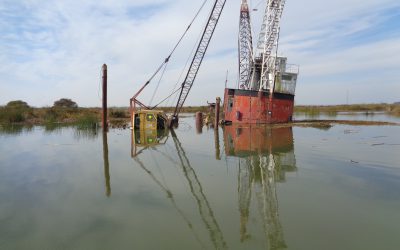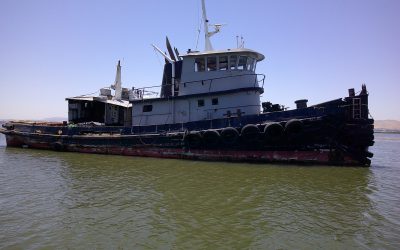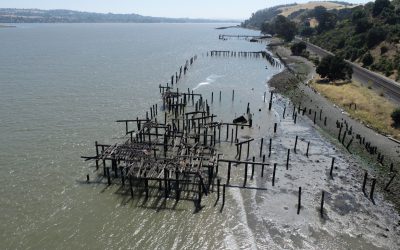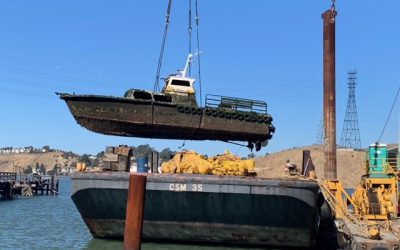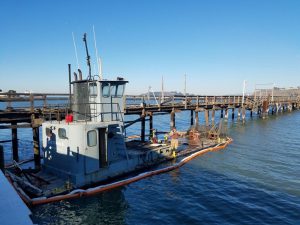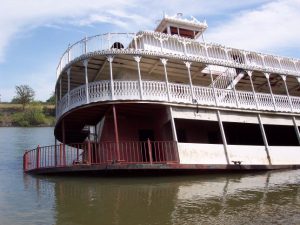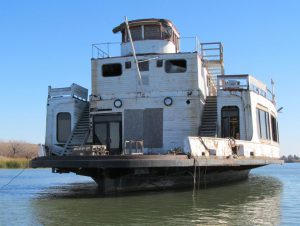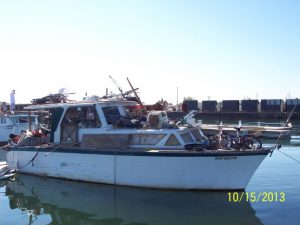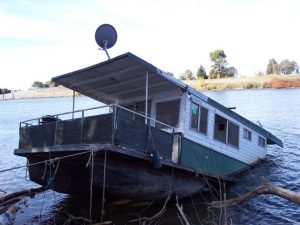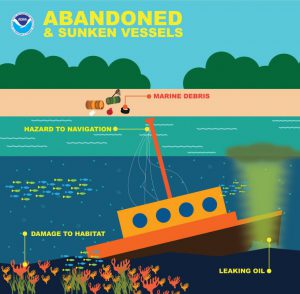
Sunken and abandoned ships can cause a lot of potential damage to the environment and the economy. Credit: NOAA Office of Response & Restoration. Larger view available.
Abandoned Commercial Vessel Removal Plan
AB 2441 (Frazier, 2019) requires the Commission to develop a plan to remove abandoned and derelict commercial vessels in the Sacramento San Joaquin Delta.
Best Management Practices for Marine Debris Removal
The Commission’s best management practices are advisory and guide local entities responsible for marine debris removal. The Commission adopted these best management practices in 2016, following the enactment of AB 1323 (Frazier), which required the Commission to adopt best management practices for marine debris removal after consulting with interested state and local entities.
Contacts
Public Land Manager
Vicki Caldwell
916.574.1894
Administrative
Jennifer Bryant
916.574.1865
Attorney
Andrew Kershen
916.574.2501
California has the fourth largest boating population in the nation, with 626,642 registered recreational vessels in 2023. While responsible owners dispose of vessels lawfully, others abandon them on state waterways where they impede navigation, interfere with boating traffic, and cause environmental harm.
Our abandoned vessel removal program began when SB 595 (Wolk, Chapter 595, Statutes of 2011) was enacted. This law established an administrative removal and disposal process for abandoned and trespassing vessels on waterways under the Commission’s jurisdiction. The law authorizes the Commission to immediately remove a vessel without notice if it hinders navigation, is a threat to vessel operators, an environmental hazard, or a public nuisance. Although the authority created in SB 595 is exclusive to the Commission, local jurisdictions have the authority to remove abandoned vessels and frequently do so. Another abandoned vessel law was enacted in 2015 when AB 1323 was signed into law. AB 1323 authorizes a public agency to remove and dispose of marine debris after 10 days if the debris is floating, sunk, partially sunk, or beached in or on a public waterway, public beach, or on state tide or submerged lands.
The Commission focuses its efforts on commercial vessels because no other state agency has both the authority and funds to do so. Recreational vessels are typically smaller and less expensive to remove, and funding may be available to remove them through the Division of Boating and Waterways Surrendered and Abandoned Vessel Exchange (SAVE) grant program.
Staff Reports
- Abandoned Commercial Vessel Removal Plan
- Delegation of Authority
- Kapiloff Land Bank Fund expenditure authorizations
- Legislation
- Program Updates
- Vessel Removals
| Staff Report | Description |
|---|---|
| 06/28/19 (100) | Consider approval of the "Abandoned Commercial Vessel Removal Plan, Sacramento-San Joaquin River Delta Region". |
| Staff Report | Description |
|---|---|
| 06/19/14 (87) | Amendment to expand the authority of the Executive Officer to take actions necessary to remove or dispose of abandoned, derelict, or trespassing vessels from state waterways; and to revise the delegation in the absence of the Executive Officer to add the Chief, External Affairs Division. |
| 02/25/22 (49) | Request that the Commission delegate authority to the Executive Officer to retain a contractor to prepare an environmental document and to conduct studies to implement a Commercial Abandoned and Derelict Vessel (CADV) Removal Program in the Sacramento-San Joaquin Delta. |
| Staff Report | Description |
|---|---|
| 10/18/18 (81) | For removal and disposal of abandoned vessels, marine debris, navigational hazards or obstructions, and derelict structures in the San Francisco area. |
| 08/23/22 (44) | For the emergency removal and disposal of marine debris in the Sacramento River; authorization of settlement in lieu of litigation; and authority to recoup costs. |
| Staff Report | Description |
|---|---|
| 01/29/09 (41) | To amend the Public Resources Code to create an administrative process that gives the Commission the ability to remove and dispose of abandoned vessels, trespassing vessels, and trespassing ground tackle. |
| 12/10/09 (41) | To amend the Public Resources Code to create an administrative process that gives the Commission the ability to remove and dispose of abandoned vessels, trespassing vessels, and trespassing ground tackle. |
| 02/08/11 (38) | To create an administrative process that gives the Commission the ability to remove and dispose of abandoned vessels, trespassing vessels, and trespassing ground tackle. |
| 04/19/18 (107) | Support State Legislation (AB 3441, Frazier). |
| 06/07/2024 (74) | Consider supporting the Abandoned and Derelict Vessel Removal Act of 2024 (H.R. 7719) introduced by Representative Garamendi to address abandoned and derelict vessels in state and federal waterways. |
| Staff Report | Description |
|---|---|
| 06/03/25 (62) | Informational update on the Commission’s Abandoned Vessels Program. |
| Staff Report | Description |
|---|---|
| 12/10/10 (40) | Authorize the Executive Officer to take action necessary and appropriate to remove and dispose of an abandoned vessel from state sovereign lands, located within the Sacramento River at Courtland, Sacramento County. |
| 09/01/11 (71) | Consider authorization for staff and the office of the Attorney General to take all steps necessary, including litigation, to cause the removal of barges, boats, a sunken crane, and other floating objects illegally occupying state land in Mayberry Slough at Donlan Island, Sacramento County. |
| 03/29/12 (108) |
Consider authorization for staff and/or the office of the Attorney General to take all steps necessary, including ejectment and litigation, to cause the removal of two vessels illegally occupying state land in the Old River at Beaver Island, Contra Costa County. |
| 12/05/12 (77) | Consider authorization for the staff of the California State Lands Commission and/or the Office of the Attorney General to take legal action against Michael Skarry to cause removal of derelict vessels, and to prohibit the unauthorized occupation of state sovereign lands at the confluence of Mokelumne River and Seven Mile Slough, Sacramento County. Removed from the agenda |
| 02/22/13 (93) | Consider authorization for staff of the California State Lands Commission and/or the office of the Attorney General to take all steps necessary, including litigation to cause compliance with the Commission’s leasing authority; and to prohibit unauthorized mooring of vessels on state sovereign land in the San Joaquin River and Seven Mile Slough; and to remove abandoned barges and cranes, at the confluence of the San Joaquin River and Seven Mile Slough, Sacramento County. |
| 09/20/13 (112) | Consider authorization for the staff of the California State Lands Commission to remove and dispose of an abandoned vessel from sovereign state lands in the Old River. |
| 12/02/13 (111) | Consider authorization for the staff of the California State Lands Commission to remove and dispose of a derelict vessel, the Polaris (USCG # 511032), illegally occupying state lands in San Pablo Bay, offshore of Lone Tree Point, city of Rodeo, Contra Costa County. |
| 08/28/19 (71) | Consider taking title to and authorizing staff to remove and dispose of abandoned vessel Vamanos on sovereign land in the Sacramento River. |
| 04/29/20 (68) | Consider taking title to and authorizing the removal and disposal of an abandoned vessel on sovereign land in the Sacramento River. |
| 06/23/20 (58) | Consider rescinding the authorization to take title to and remove and dispose of an abandoned vessel; authorize the executive officer in cooperation with the office of the attorney general to bring any appropriate civil action against the registered owner of the vessel Jerel D. Elliott, Jr., and any other potentially responsible party, to remove and dispose of abandoned vessel CF 5601 CK or to recoup costs related to its removal and disposal; direct staff to seek funds that can be expended to remove and dispose of vessel CF 5601 CK and, if such funds are found and the executive officer determines it to be financially prudent and in the state’s best interests, to contract for removal and disposal of the vessel; on sovereign land in the Sacramento River. |
| 10/21/21 (31) | Authorize staff to take title to, remove, and dispose of two abandoned vessels in Sevenmile Slough, Sacramento County; contract for removal and disposal; and seek to recoup costs. |
| 08/23/22 (15) | Consider taking title to and authorizing the removal and disposal of an abandoned barge Granted sovereign land in the San Joaquin River, Antioch, adjacent to 111 Fulton Shipyard Road, Antioch, Contra Costa County |
| 06/05/23 (83) | Consider taking title to and authorizing the removal and disposal of an abandoned vessel on sovereign land in Haypress Reach, San Joaquin River, near McDonald Island, San Joaquin County |
| 06/05/23 (84) | Consider taking title to and authorizing the removal and disposal of an abandoned vessel on Sovereign land in the Calaveras River, adjacent to 2929 Calariva Drive, Stockton, San Joaquin County |
| 06/05/23 (85) | Consider taking title to and authorizing the removal and disposal of an abandoned vessel on sovereign land in the Sacramento River, near Freeport, Sacramento County |
| 08/17/23 (59) | Consider taking title to and authorizing the removal and disposal of three abandoned vessels, on sovereign land in Fraser Shoal, Broad Slough, Sacramento County, and authorizing staff to enter a settlement agreement |
| 08/17/23 (60) | Consider taking title to and authorizing the removal and disposal of an abandoned vessel on sovereign land in Mayberry Slough, near Donlon Island, Sacramento County |
| 06/07/24 (64) | Consider taking title to and authorizing the removal and disposal of twenty-two abandoned vessels on sovereign lands in Fraser Shoal, Broad Slough, Sacramento County |
| 08/29/24 (63) | Consider taking title to and authorizing the removal and disposal of an unnamed abandoned wooden tugboat on sovereign lands in White Slough, adjacent to King Island, San Joaquin County |
| 08/29/24 (64) | Consider taking title to and authorizing the removal and disposal of an unnamed abandoned and sunk steel barge on private submerged lands in Little Potato Slough, between Little Venice Island and Empire Tract, San Joaquin County |
| 08/29/24 (65) | Consider taking title to and authorizing the removal and disposal of an unnamed floating barge on sovereign lands in the San Joaquin River, adjacent to Mandeville Tip County Park, San Joaquin County. Removed from agenda. |
| 08/29/24 (66) |
Consider taking title to and authorizing the removal and disposal of an unnamed dredger on sovereign land in the San Joaquin River, near Windmill Cove Marina, San Joaquin County. Removed from agenda. |
| 10/17/24 (53) | Consider taking title to and authorizing the removal and disposal of an unnamed floating barge, California registration number CF 3542 SX, on sovereign lands in the San Joaquin River, adjacent to Mandeville Tip County Park, San Joaquin County. |
| 12/17/24 (58) | Consider taking title to and authorizing the removal and disposal of the Vaquero II located on sovereign lands in Sandmound Slough, near Bethel Island, Contra Costa County. |
| 12/17/24 (59) | Consider taking title to and authorizing the removal and disposal of the sailboat Perseverance on a navigable waterway owned by the United States, Sears Point Wetlands Restoration Area, San Pablo Bay National Wildlife Refuge, Sonoma County. |
| 04/02/25 (45) | Consider taking title to and authorizing the removal and disposal of crane barge BD-245, crane barge Peanut, and an unnamed sunk barge and associated debris located on sovereign land in Sevenmile Slough, Sacramento County; and entering into an agreement with the California Department of Parks and Recreation for the temporary use of state park land. |
| 04/02/25 (46) | Consider taking title to and authorizing the removal and disposal of three abandoned vessels on sovereign land in Mayberry Slough, near Donlon Island, Sacramento County. |
| 06/03/25 (53) | Consider taking title to and authorizing the removal and disposal of a sunk barge located on sovereign lands in New York Slough, near Winter Island, Contra Costa County. |
Examples of recently removed abandoned vessels
The State Lands Commission Removes Abandoned Vessels Languishing in the Sacramento-San Joaquin Delta
Commissioners:Eleni Kounalakis, Lieutenant Governor, ChairMalia M. Cohen, California State Controller, MemberJoe Stephenshaw, Director of the Department of Finance, Member Media ContactSheri Pemberton, Chief of External Affairs916.477.0691 | Sheri.Pemberton@slc.ca.gov...
The Life Cycle of a Commercial Abandoned and Derelict Vessel Removal
The photos below show the steps to remove and demolish the Double Eagle tugboat from the Delta. Background information for the Double Eagle and the Commission’s formal action is in the staff report. Scroll through the gallery to see the process. Photos courtesy of...
Eckley Pier Piling Removal Project
The Eckley Pier Removal Project in the Carquinez Strait near the town of Crockett is complete! On October 30, 2023, Commission staff and CS Marine began the removal process of derelict pilings from the Carquinez Strait. Demolition was completed on November 11, 2023,...
Removal and disposal of abandoned and derelict vessels in the Carquinez Strait
The Commission and its contractor removed and disposed of all abandoned and derelict vessels in the Carquinez Strait in the town of Crockett. The Commission removed five vessels: a 45-foot CalBay workboat, a 60-foot landing craft, a pontoon boat, and two large steel...
Older examples of removed abandoned vessels
Gretchen E.
In 2018, the Commission and the U.S. Coast Guard removed the derelict 55-foot, steel-hulled, landing craft–style Gretchen E. at Crockett Marina in Contra Costa County. The removal was precipitated by the U.S. Coast Guard responding to reported oil sheens and discovering oil bubbles coming from the Gretchen E. Commission staff worked with the U.S. Coast Guard to remove and demolish the Gretchen E. The initial plan, lifting the vessel out of the water by crane barge, was discarded because the Marina was too narrow for a barge to enter. instead, we refloated the boat, using a small boat to tow it out of the marina and then using two tugs—one on either side—to tow it across the Strait to Mare Island. This approach worked. We towed the Gretchen E to Mare Island and lifted it out of the water. We removed hazardous material and sent the vessel to a scrapper for demolition.
Spirit of Sacramento
The old Spirit of Sacramento was built in 1942 by the Berkeley Steel Construction Co. as a snag boat for the Army Corp. of Engineers and named the Putah. It was last documented by the Coast Guard in 2000 as the Grand Romance at 82 ft. in length; 32.5 ft. in breath; drawing 3.9 ft. at a gross tonnage of 97 tons.
Previously named the Chici San it was used in the 1954 movie “Blood Alley” starring John Wayne. It was acquired by Star Excursions Inc. in 1991 for a show boat in Old Sacramento. In 1996 it burned to the waterline and was sold and rebuilt then moved it the location in the photographs on the Sacramento River. There it periodically was swamped and sunk until it was raised and removed by court order as the result of a lawsuit by the Commission.
San Diego
With her sister ship the Coronado, the San Diego, built by the Moore Drydock Company in 1931 in Oakland, at 191 ft. in length and 43 ft. wide, provided car and passenger transportation between the City of San Diego and Coronado Island before the bridge was built in 1969. Then purchased by the Olympic Navigation Company she served the route between Port Townsend and Whidbey Island in Washington. The San Diego moved to Vancouver, British Columbia when its owners ceased operation in 1974 and remained for 20 years as the Klondike Queen, waiting to be rebuilt as a paddlewheel excursion boat.
Brought back to California in 1994, she became the failed venture of the City of Antioch to turn her into a floating restaurant called Huckleberries. Sold to a Sacramento Corporation which operated riverboats, she partially burned and was eventually traded to an individual for Delta land. Then the San Diego was moored in the Sacramento River at the lower tip of Decker Island.
A phone inquiry from the Solano County Sheriff’s marine patrol questioned her right to be moored at that location, side tied to the Faithful, a 293 ft. former cruiser/hospital ship. A threat of legal action resulted in the removal of the Faithful, but a lawsuit and years of negotiation was required to finally remove and demolish the San Diego. Various parts of her structure have been retained and are on display at the San Diego Maritime Museum.
Oakland / Alameda Estuary Cleanup
Officers with the Oakland police department first noted what a cleanup could accomplish when First Lady Michelle Obama visited the Estuary to christen a ship. On patrol of the Estuary, the large number of abandoned and derelict boats that littered the waters and shores were observed on a daily basis. The police department contacted the California Department of Resources, Recycling, and Recovery (CalRecycle) and requested the Commission exercise its authority under Public Resources Code Section 6302.1 to remove the vessels. With funding from CalRecycle and a matching grant from the Trust created from the penalties of the Cosco Busan oil spill, the effort started.
An initial survey in 2012 recorded the location of each boat, which was logged and photographed. Once funding was confirmed in 2013, a task force of Oakland and Alameda police, accompanied by other police agencies, the Coast Guard, and the California Department of Fish and Wildlife, posted a 30-day notice of trespass on each boat. Boats remaining after the 30-day notice expired were towed and impounded. The few seaworthy vessels were eligible for release, but the majority were un-seaworthy and demolished. Altogether, trespass notices were posted on 38 boats, 18 boats left voluntarily, five moved within the Estuary and were later located and demolished, two left the Estuary but were later found derelict in other areas and recovered and demolished. A total of 58 abandoned or derelict boats were removed and demolished along with pilings, docks, and other shore debris.
Courtland Pontoon Boat
This pontoon boat was free floating down the Sacramento River near the town of Courtland. Commission staff procured the services of a Sacramento auto wrecking company and managed to pull the boat up the river bank and onto highway 160. After it emerged from the river it was discovered that its pontoons were flooded, which added about ten thousand pounds to the effort. Once they were drained, it was hauled off to the wrecking company’s yard.


